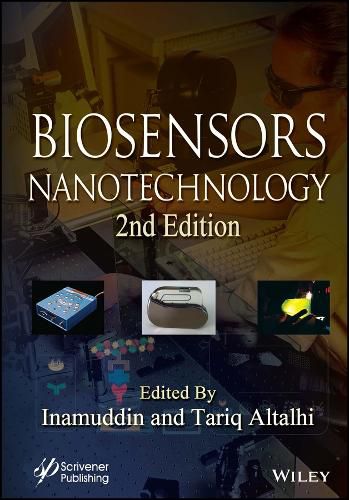Readings Newsletter
Become a Readings Member to make your shopping experience even easier.
Sign in or sign up for free!
You’re not far away from qualifying for FREE standard shipping within Australia
You’ve qualified for FREE standard shipping within Australia
The cart is loading…






BIOSENSORS NANOTECHNOLOGY The second edition of Biosensors Nanotechnology comprises 20 chapters and discusses a wide range of applications exploited by biosensors based on nanoparticles including new domains of bionics, power production and computing.
The biosensor industry began as a small, niche activity in the 1980s and has since developed into a large, global industry. Nanomaterials have substantially improved not only non-pharmaceutical and healthcare uses, but also telecommunications, paper, and textile manufacturing. Biological sensing assists in the understanding of living systems and is used in a variety of sectors, including medicine, drug discovery, process control, environmental monitoring, food safety, military and personal protection. It allows for new opportunities in bionics, power generation and computing, all of which will benefit from a greater understanding of the bio-electronic relationship, as advances in communications and computational modeling enable us to reconsider how healthcare is offered and R&D and manufacturing are enhanced.
In this fast-evolving discipline, the combination of nanoscale materials with biosensor technology has gained a lot of traction. Nanostructures have been used to increase the adherence of biosensor materials to electrode surfaces, print nano barcodes on biomaterials, increase the pace of bio-responses, and amplify the electric signal. Some of the topics discussed in the book include: Bioreceptors for Cells; Bioreceptors for Enzymatic Interactions; Dendrimer-Based Nanomaterials for Biosensors; Biosensors in 2D Photonic Crystals; Bioreceptors for Affinity Binding in Theranostic Development; Biosensors for Glucose Monitoring; Metal-Free Quantum Dots-Based Nanomaterials for Biosensors; Bioreceptors for Microbial Biosensors; Plasmonic Nanomaterials in Sensors; Magnetic Biosensors; Biosensors for Salivary Biomarker Detection of Cancer and Neurodegenerative Diseases; Design and Development of Fluorescent Chemosensors for the Recognition of Biological Amines and Their Cell Imaging Studies; Application of Optical Nanoprobes for Supramolecular Biosensing; In Vivo Applications for Nanomaterials in Biosensors; Biosensor and Nanotechnology for Diagnosis of Breast Cancer; Bioreceptors for Antigen-Antibody Interactions; Biosensors for Paint and Pigment Analysis; Bioreceptors for Tissue; Biosensors for Pesticide Detection; and Advances in Biosensor Applications for Agroproducts Safety.
Audience
The book is written for a large and broad readership including researchers, industry engineers, and university graduate students from diverse backgrounds such as chemistry, materials science, physics, pharmacy, medical science, biomedical engineering, electronics engineering, and nanotechnology.
$9.00 standard shipping within Australia
FREE standard shipping within Australia for orders over $100.00
Express & International shipping calculated at checkout
BIOSENSORS NANOTECHNOLOGY The second edition of Biosensors Nanotechnology comprises 20 chapters and discusses a wide range of applications exploited by biosensors based on nanoparticles including new domains of bionics, power production and computing.
The biosensor industry began as a small, niche activity in the 1980s and has since developed into a large, global industry. Nanomaterials have substantially improved not only non-pharmaceutical and healthcare uses, but also telecommunications, paper, and textile manufacturing. Biological sensing assists in the understanding of living systems and is used in a variety of sectors, including medicine, drug discovery, process control, environmental monitoring, food safety, military and personal protection. It allows for new opportunities in bionics, power generation and computing, all of which will benefit from a greater understanding of the bio-electronic relationship, as advances in communications and computational modeling enable us to reconsider how healthcare is offered and R&D and manufacturing are enhanced.
In this fast-evolving discipline, the combination of nanoscale materials with biosensor technology has gained a lot of traction. Nanostructures have been used to increase the adherence of biosensor materials to electrode surfaces, print nano barcodes on biomaterials, increase the pace of bio-responses, and amplify the electric signal. Some of the topics discussed in the book include: Bioreceptors for Cells; Bioreceptors for Enzymatic Interactions; Dendrimer-Based Nanomaterials for Biosensors; Biosensors in 2D Photonic Crystals; Bioreceptors for Affinity Binding in Theranostic Development; Biosensors for Glucose Monitoring; Metal-Free Quantum Dots-Based Nanomaterials for Biosensors; Bioreceptors for Microbial Biosensors; Plasmonic Nanomaterials in Sensors; Magnetic Biosensors; Biosensors for Salivary Biomarker Detection of Cancer and Neurodegenerative Diseases; Design and Development of Fluorescent Chemosensors for the Recognition of Biological Amines and Their Cell Imaging Studies; Application of Optical Nanoprobes for Supramolecular Biosensing; In Vivo Applications for Nanomaterials in Biosensors; Biosensor and Nanotechnology for Diagnosis of Breast Cancer; Bioreceptors for Antigen-Antibody Interactions; Biosensors for Paint and Pigment Analysis; Bioreceptors for Tissue; Biosensors for Pesticide Detection; and Advances in Biosensor Applications for Agroproducts Safety.
Audience
The book is written for a large and broad readership including researchers, industry engineers, and university graduate students from diverse backgrounds such as chemistry, materials science, physics, pharmacy, medical science, biomedical engineering, electronics engineering, and nanotechnology.